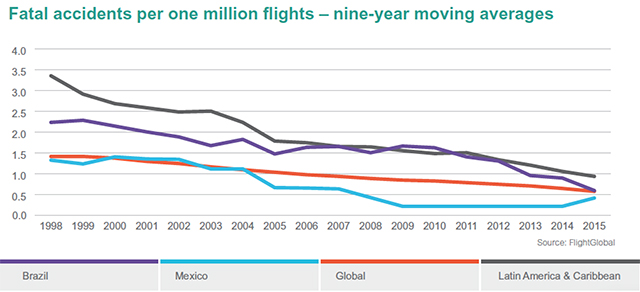The past two years have seen few serious accidents in the Latin America and Caribbean area, and those that have happened have involved small turboprops. But two years is a short time in aviation safety terms and – given the region’s mediocre safety record over decades – not long enough to impress experts at bodies such as the International Civil Aviation Organisation.
The graph below, using figures assembled by Flight Ascend Consultancy, illustrates the long-term story. Using a nine-year moving average to derive the trend, the region still shows a higher accident rate than the world average, although it is closing with the global figures even as the latter are continuing to improve. That is the good news.

The bad news is that ICAO is not impressed with Latin American and Caribbean compliance with its standards and recommended practices (SARP) for safety oversight and infrastructure.
The region’s intentions are good, however. At Panama City in June the Regional Aviation Safety Group – Pan American (RASG-PA) restated its intention to reach, by 2020, a reduction of fatal accidents to 50% of the rate a decade earlier.
According to ICAO’s most recent safety report for the Americas, safety priorities for Latin America and the Caribbean, based on overall risk assessment, have been determined as loss of control in flight (LOC-I), runway excursion, controlled flight into terrain and mid-air collision.
SKILLS SHORTAGE
The industry knows what it has to do, but ICAO’s Universal Safety Oversight Audit Programme (USOAP) indicates that safety oversight at a national level in the Latin American and Caribbean region is handicapped by the fact that it has, in absolute terms, the lowest level of technical staff qualification and training of all the regions, including in its accident and incident investigation services. Also revealed by USOAP is the need for dramatic improvement in infrastructure investment, particularly air navigation services, ground aids and airports.
The RASG-PA 2016 conference in June recognised the need to continue to raise awareness of ground movement discipline to reduce runway incursion risk. Another matter that calls for careful monitoring is the successful introduction of more precision area navigation and performance-based navigation procedures in airport terminal areas.
And in common with all other regions, RASG-PA recognised the need to raise pilot awareness of the importance of stabilised approaches and skilful total energy management on final approach to avoid runway excursions.
The graph relates to fatal accidents since 1990 for major airlines and commuter airlines that operate jet or turboprop aircraft able to carry more than 14 passengers or the cargo equivalent. Crashes resulting from deliberate acts of violence are not included.
To produce reliable long-term trend data, the graph shows nine-year moving averages, so the first data point is for the nine-year period ending in 1998 and the last is for the nine years to the end of 2015. A moving average is used because accidents occur relatively rarely now, and annual graphs using such small figures tend to produce meaningless spikes.
Latin America’s 3.35 per million figure for 1998 was 2.4 times worse than the overall world rate at the time. For the period ending 2015, Latin America’s fatal accident rate was 0.93 per million – 3.6 times better than its performance 17 years earlier.
However, the world has also improved its safety performance during this time and its rate is now 0.57, an improvement of 2.5 times compared with Latin America’s 3.6. So the region is catching up – if slowly – with the world average.
Performance is not, of course, uniform across the continent. Some countries do better than others: Brazil is now more or less up to the world average, while Mexico and Chile are better than the world average, according to Flight Ascend Consultancy’s chief safety analyst, Paul Hayes.
For our coverage of the ALTA Airline Leaders Forum taking place in Mexico City on 13-15 November, visit www.flightglobal.com/alta
Source: Cirium Dashboard


























